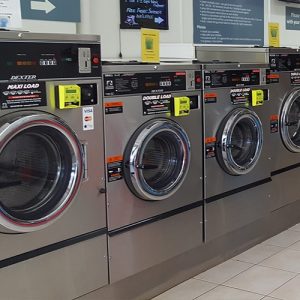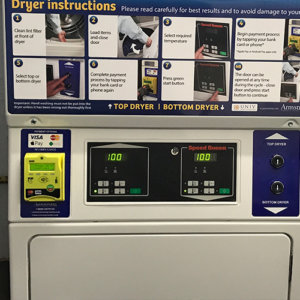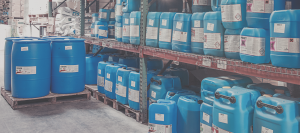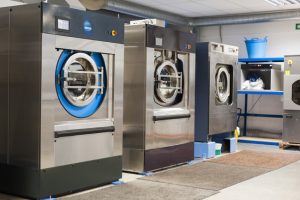17 Ways the Laundry Industry Has Changed Over Time
No matter how often you do it, laundry is one of those chores that never seem to end. We all struggle to keep up with the eternal cycle of fussing over dirty clothes, sorting, washing, drying, folding/ironing, and finally, putting clean laundry away in dresser drawers – only to see a new pile growing in the laundry basket the next morning. Is it a wonder then that the commercial laundry industry is a $40 billion market opportunity !? But where did commercial laundry find its roots and how did it come to be so popular? Which are the biggest factors impacting commercial laundry today? And even more importantly, what does the future entail for commercial washer and dryer services? Let’s find out…
All you need to know about the commercial laundry industry
1. The fascinating origin of commercial laundry services
The history of commercial laundry services can be traced back to the Roman Empire. Romans placed a great deal of importance upon hygiene and physical appearance and had formalized a large-scale public system of garment washing and drying through ammonia and water. The cloth washers were known as fullones, who collected clothes from Roman households and washed them at local laundries called fulleries. Given the labor-intensive nature of the job, men were responsible for doing laundry in ancient Rome – a stark contrast to other cultures where laundry work typically fell on women.
2. Industrial Revolution and commercial washing machine
It wasn’t until the 18th and 19th centuries that the first iterations of the modern washing machine made an appearance on the heels of the Industrial Revolution. The laundry process was mechanized through hand-operated paddles or dollies to churn clothes inside a tub. Electric clothes washers, in which a motor rotated the tub, began to appear around 1900. Shortly after, commercial laundries started sprouting across US cities. It is estimated that there were 3,550 commercial laundry providers in New York City at the beginning of the Great.
3. The world’s largest outdoor commercial laundry shop
But not every commercial laundry service relies on automatic machines. The city of Mumbai in India is home to the world’s biggest open-air commercial laundry, Dhobi Ghat since 1890. More than 7,000 people hand-wash and air-dry over 100,000 clothes at Dhobi Ghat every day. Raking in an annual turnover of USD 13.6 million, Dhobi Ghat has even earned a Guinness Book of World Records entry for ‘most people hand-washing clothes at a single location’.
4. Commercial laundry use across the globe
According to a Neilsen survey, people in Africa and the Middle East are more likely to use a commercial washing machine for their laundry than the rest of the world (28 percent versus 6 percent globally). At 8 percent, North America is the second-most popular market for a self-service laundry facility or a laundromat, followed by Asia-Pacific (5 percent), Latin America (4 percent), and Europe (3 percent). But it must be noted that as disposable incomes continue to rise in developing markets, an increasing number of households are outsourcing the laundry.
5. The growing market of industrial laundries
Even as households look to expunge laundry from their list of domestic chores, the commercial laundry market has another type of major clientele – industrial users. This sector includes hospitals and clinics, hotels and motels, restaurants, spas and salons, and assisted living centers. For their efficient day-to-day functioning, these industries depend on commercial washer and dryer machines that can churn out large-capacity loads. And given the importance of hygiene in hospitals, spas, and restaurants alike, industrial laundries are increasingly leveraging germ-fighting solutions like ionic silver in the washing process.
6. Where the term ‘laundromat’ comes from
Before the term ‘laundromat’ came into being, commercial laundry facilities in the United States were known as ‘washeries’ or ‘Wash-a-teria’. Laundromat (most likely originating from laundry + automat) was actually a proprietary brand name for a type of washer sold in the US in the 1940s. The name became so popular that it stuck around even after the brand closed production and came to represent coin-operated, self-service laundry shops instead. In the United Kingdom and Europe, the preferred term for a self-service laundry facility is ‘launderette’.
7. Prohibition on public drying of clothes
Interestingly, Americans have a reputation for being anti-clothesline. In most states, community associations and landlords have imposed rules that forbid millions of homeowners to dry their laundry in their backyards. Why? Because one, clothes flapping around in the wind are aesthetically displeasing, and two, it lowers the curb appeal and, therefore, property prices in the neighborhood. Rebels disobeying these rules risk legal action in the United States. As such, for many middle-class families, prove to be an expensive alternative to private ownership of washers and dryers that require larger sums of disposable income. And since, at a laundromat, a family’s entire laundry can be done simultaneously using multiple machines, customers witness significant time-use benefits too.
8. Moving beyond the coin: washing machines
After operating in a cash-only business model for decades, commercial washing machine providers have now realized that introducing cashless payments can make the laundromat experience easier for consumers, improve the store’s productivity, and help them earn more money. In the last few years, card-operated washing machine suppliers have witnessed a huge demand surge with laundry shop operators looking to spend less time hauling coins and counting cash. Since a washing machine card reader can be installed on individual machines, on stacks of washers and dryers, or at a central pay station, operators can start offering flexible laundry (credit card operated) services at their convenience.
In 2020 and beyond especially, when COVID-19 has changed the public perception of cash and you have an option to pay for almost anything through an app, laundromats that do not offer card-operated laundry machines run the risk of alienating customers and driving themselves into bankruptcy.
9. Types of laundromats: Fully attended, partially attended, unattended
Whether it’s best to hire attendants to assist customers or to allow the customers to go in, use the equipment and leave without any contact with someone representing the store, is a business decision that operators need to make. Apart from attending to customers and maintaining the cleanliness of the store, attendants protect a laundromat against the threat of vandalism just by being there. But hiring an attendant comes with its own set of costs: hiring, training, wages, bookkeeping, supervision, etc. This is why many 24-hour laundry operators decide to either go the partially-attended way where an attendant is present on-premises for a limited number of hours every day (such as when the store sees maximum footfall from an older demographic who could require assistance) or leave the store completely unattended.
It must be noted that an unattended business model works best on card-operated laundry machines where laundromat owners can keep an eye on all transactions and monitor machine health remotely.
10. Self-service laundry and customer education
As is the case with any self-service industry, the success of a business correlates directly with proactive customer education. So, while washing machine suppliers must apprise laundry service operators of the benefits of adopting new technologies like a washing machine card reader, operators must pass on the knowledge to the customers for the successful adoption of said technologies. For example, a flyer could be put up detailing the different payment options available in a washing machine dryer (card-operated) or explaining how a washer works.
For maximum retention, operators are known to send newsletters and emails to customers or conduct awareness days around commercial washing machine techniques and safety protocols. Injecting transparency into the business and fostering accessibility goes a long way with commercial laundromat customers – more so if the launderer offers pick-and-drop services and customers don’t witness the actual laundry operations in person.
11. The need to outsource laundry
Lately, on-demand laundry services are witnessing an uptick. Customers separate their wash into bags, which are then retrieved by the launderer’s valets. The cleaning takes place at a centralized industrial laundry, and home delivery of finished laundry is done the next day.
Even with the convenience of 24-hour laundromats and easy availability of washing machine dryer (card operated), doing laundry is tedious and time-consuming. If you have a big family and little help, the entire process can literally take hours every week. And that precious time could otherwise be spent doing something fun with friends or family. Little surprise that in a survey of 2,000 Americans who live with a partner, doing laundry came up as the second-most hated chore of all-time (the first being the dishes). Why else would you find endless Internet pages dedicated to laundry jokes as well as on-demand laundry service providers?
12. Wash formula and chemicals: Choosing the right mix
The efficiency and effectiveness of everyday operations at an on-demand commercial laundry can vary hugely with the different types of wash formula and essential chemicals used. This is why successful on-demand commercial launderers pay utmost attention to things like softening agents, bleaching agents, alkaline builders, and neutralizing sours. Commercial washer and dryer services choose their chemicals in accordance with the fiber content, the color of the fabrics, soil types, wash equipment, water conditions, etc. The right chemistry at the right wash temperature bolsters the entire wash process and enhances the longevity of the linen and garments.
At self-service laundry (credit card operated) outlets also, it is not uncommon to find cashless vending machines stocked up with recommended laundry items like mini detergent bottles, fabric softeners, or dryer sheets.
13. The ‘concept laundromat’ trend is catching on
On-demand laundry services may be catching on but the neighborhood laundromat hasn’t thrown in the towel yet. To attract millennials and young working professionals – the biggest target demographic for laundry pick-and-drop services – self-service laundries have started adding on other services, such as dry cleaning, tailoring and altering clothes, shoe repairs, and tanning booths, that can be availed while the machines do the laundry.
Many operators also lease cashless vending machines to sell snacks and drinks to the waiting customers. But forward-looking card-operated washer operators are now doubling up their stores as cafes and craft breweries. This trend is especially noticeable in cities like New York, where pinball machines chime happily next to card-operated washing machines. In Illinois, laundromats organize pizza nights, whereas, in Montana, a laundry bistro serves topical cocktails like the ‘orange, white and blue Tide Pod shot’!
14. Climate change and sustainable commercial laundry
When it comes to water and energy use, traditional commercial laundry machines are known for their wastefulness. But with climate change becoming a reality, the focus on limiting energy and water, as well as adopting environmentally-friendly laundry processes, has gained momentum. The need to seek-out sustainable business practices has become even more urgent with both the federal government and mindful customers becoming vigilant about how a business treats the environment. This has led to the development of near-waterless laundry systems. These machines allow commercial laundry service providers to use less wash formula and save water by up to 80 percent and lower the electricity use by up to 50 percent on every load. To cut down energy use even further, laundries can equip dryers with moisture sensors which, instead of running for the whole cycle, stop the machine as soon as the clothes become dry. Meanwhile, the overuse of chemicals can be curbed by using smart dispensers that automatically determine the chemical mix based on the fabric type and load weight.
Needless to say, adopting these practices will not only enable commercial washer and dryer service providers to reduce their environmental footprint, but they would also be able to reap the benefits of major cost-savings in their day-to-day operations in the long run.
15. Intelligent commercial laundry systems
While using technologically-advanced machinery is one way to reduce costs and make a laundry business more sustainable, unparalleled efficiencies can be achieved through the use of web-based management tools and washing machine card reader. When a commercial laundromat opts to get a laundry card reader installed on the machines, the benefits go beyond offering multiple payment methods to customers. A laundry card reader from an industry-leading company like Nayax doubles up as a complete management platform for unattended card-operated laundry machines.
This means operators can keep an eye on the sales and other metrics on a washing machine dryer (card operated) remotely in real-time. By combing the data, they can identify consumer behavior such as at what time of the day or on which days of the week the laundromat receives the maximum business. Commercial laundry service providers can then use that information to create happy hours during off-peak times or offer other discounted promotions to drum up business during traditionally quieter periods. Since machine attributes can also be controlled remotely, operators can start or stop a machine to clear errors without having to visit the laundromat in person. Moreover, smart alerts notify operators in real-time via text message or email if a machine gets unplugged or if anything is not working correctly, preventing revenue loss. Laundry shops can also save big on maintenance costs by tracking which card-operated washer is being used most and rotate the commercial washer and dryer inventory to allow equal wear and tear on the machines’ parts and maximize efficiency.
16. The impact of COVID-19 on commercial laundry service
One key recommendation given by the Centers for Disease Control and Prevention to prevent the spread of the novel coronavirus is to wash laundry thoroughly. A heightened focus on cleanliness has anyway become the norm these days – which could have been good news for commercial laundry service providers, except that it isn’t. Given the continued surge in COVID-19 cases, millions of customers are equating going to a laundromat with potentially coming into contact with someone who is an asymptomatic carrier of the coronavirus. On the other hand, they are worried about endangering their health anyway by not washing their clothes. But if the recent business figures are any indicator, it seems that people have chosen the latter option as the lesser evil. According to Irving Weber & Associates (IWA), “While the Laundry and Linen Services market is still expected to see growth over the next few years, its immediate outlook for 2020 is not so rosy. In fact, the sector is expected to decline from $106.2 billion in 2019 to $104 billion in 2020. While this may not seem like a major dip, it’s been enough to close some doors or at least have business owners rethink their business strategy for the rest of the year.” Another major factor which is contributing to the declining demand for laundry service is the ‘Work From Home’ trend. Even though blanket stay-at-home orders have been lifted across the globe, concerned businesses are still allowing employees to work from home, wherever possible. And so, the need for fresh laundry on a daily basis has reduced, putting a damper on commercial laundry services.
As IAW explains, if a dry cleaner used to run 500 items daily, they are likely working with 50 pieces today. This doesn’t just limit the laundry service’s earnings, but it also hurts the staff. Because if not enough business is coming in, some staff has to be let go, while the remaining employees stretch themselves thin to take on more load. The commercial washer and dryer service providers are also suffering from the economic domino effect originating from the plummeting revenues in the hospitality industry. With hotels being shut or fewer travelers needing a change of towels or bed sheets, industrial laundries are directly impacted. Similarly, with colleges shut down, revenues from commercial laundry machines found on campuses had also taken a nosedive.
17. Future of commercial laundry
While the industry is expected to see a rebound in the coming months with travel restrictions being lifted and students returning to campuses, in the meantime, laundry service providers are also finding ways to alleviate the concerns that people have about visiting a public laundromat. Just like restaurants are allowing food delivery or curbside pickups, laundromats are also experimenting with a semi on-demand or fully-on-demand service model. Moving forward, as the need for an on-demand approach to laundry increases, mobile apps, and card-operated washing machines can be expected to become the norm. To make customers come back to their laundromat, operators will seek ways to make it worth their time and wallet by introducing discounts and loyalty programs and allowing consumers to pay for their laundry with a virtual loyalty card on a mobile app or a card loaded onto an app.
Additionally, the multi-housing industry can also be expected to seek out washing machine suppliers for their premises as tech-savvy millennials graduate and get apartments.
The bottom line
Summing up, the commercial laundry industry has come a long way from its humble beginnings in the Roman Empire. With increasing cultural acceptability of outsourcing of household chores and more women joining the workforce, the demand for commercial laundry services is only going up. Commercial laundry gains even more importance from the lens of a sustainable future since large-scale industrial washers use less than half of the water required by home washing machines, per pound of laundry. In the future also, commercial laundry service operators will be able to gain from the technological advancements being made in near-waterless large-scale laundry systems. Meanwhile, traditional laundromats are also reinventing themselves and finding novel ways to retain customers as new-age, on-demand laundry service providers find a footing in the industry. From offering lucrative add-on services to keeping consumers entertained through exciting food and beverage options, laundromats are fast regaining their importance and becoming more than a mundane fixture in people’s lives. In a post-COVID world, where there is more importance on going cashless than ever, we can expect all laundromats to install a laundry card reader and make their services for laundry credit . Mobile apps can also be expected to become the norm for scheduling laundry pickups and drops and making payments.



















